Thermo mechanical Finite Element Analysis of the plasma Wire Arc Additive Manufacturing process in DEFORM® 13
IF 4
Q2 MATERIALS SCIENCE, MULTIDISCIPLINARY
引用次数: 0
Abstract
This study investigates the potential of Finite Element Analysis in DEFORM® to predict the thermal history, deformation, residual stress state and grain growth in the Wire Arc Additive Manufacturing processes of Ti–6Al–4V. The temperature dependent material model for Ti–6Al–4V was extended and adapted to improve the representation of contact boundary conditions within DEFORM®, focusing on Additive Manufacturing. A single layer quad-mesh approach was employed alongside dummy heat sources to simulate the process by accurate layer wise activation within the arc welding module. The model utilized a normalized double-ellipsoid heat source and introduced a power adaptation strategy to account for differences in volumetric deposition. The extracted thermal history showed very good agreement to corresponding thermocouple measurements. The accuracy of the resulting deformation state was validated using a 3D scan, while the predicted grain size distribution was compared against an as-built micrograph. The simulation showed good overall accuracy, though limitations were noted in the grain size model, which was inadequate in predicting the more complex texture of the mixed -microstructure typical for Ti–6Al–4V. Seven heat treatment strategies were evaluated to address mechanical anisotropy. Solution annealing followed by water quenching and subsequent low temperature aging was found to be most effective.
DEFORM®13中等离子丝弧增材制造过程的热机械有限元分析
本研究探讨了DEFORM®有限元分析在预测Ti-6Al-4V电弧增材制造过程中的热历史、变形、残余应力状态和晶粒生长方面的潜力。Ti-6Al-4V的温度相关材料模型进行了扩展和调整,以改善DEFORM®中接触边界条件的表示,重点是增材制造。采用单层四网格方法与虚拟热源一起,通过在弧焊模块内精确分层激活来模拟过程。该模型采用归一化双椭球热源,并引入功率自适应策略来考虑体积沉积的差异。提取的热历史与相应的热电偶测量结果非常吻合。通过3D扫描验证了变形状态的准确性,同时将预测的晶粒尺寸分布与构建的显微照片进行了比较。尽管晶粒尺寸模型存在一定的局限性,不足以预测Ti-6Al-4V混合α/β-组织的复杂织构,但模拟结果总体精度较高。评估了7种热处理策略以解决机械各向异性问题。溶液退火后再进行水淬和低温时效是最有效的。
本文章由计算机程序翻译,如有差异,请以英文原文为准。
求助全文
约1分钟内获得全文
求助全文

 求助内容:
求助内容: 应助结果提醒方式:
应助结果提醒方式:


